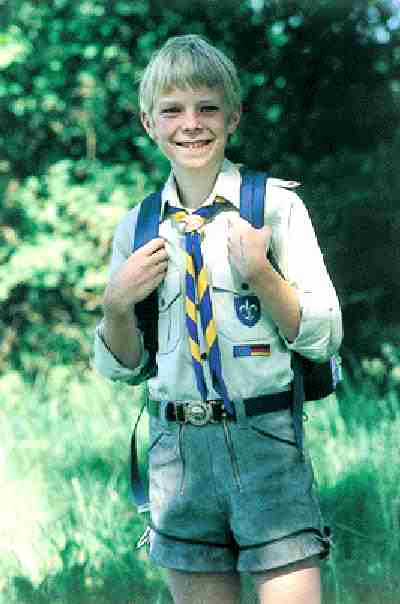
Figure 1.--This German Scout wears grey lederhosen with black trim. Notice the German badge on his shirt. Also notice the destinctive belt buckle. |

|
Lederhosen are generally associated with German and Austrian youth groups. HBU has noted them worn by boys in other countries as well. They were not restricted, however, just to these countries. They were also commonly worn by boys in Norway. I'm not sure about other Scandinavian countries. We thought they were worn by Swiss Scouts, but a Swiss reader tells us that ths was not the case. Lederhosen do not appear to have been popular in Poland, perhaps because they were assocaiated with Germany. They were also worn to some extent in France. I have never seen them in England.
he garments worn by Austrian youth groups seem similar to those worn in other countries, especially Germany. One noticeable trend in austria is that Lederhosen were particularly popular and often worn with youth group uniforms. Lederhosen wwee commonly worn in the first half of the 20th century. Lederhosen are generally most associated with German and Austrian youth groups. The connection may be the strongest with Austrian youth groups because lederhosen are an Alpine style and all of Austria is an alpine country. In contrast only southern Germany, especially Bavaria is associated with the Alps. We note Austrian boys wearing Lederhosen with the Wandervogel, Boy Scouts and Hitler youth. We are less sure about the Communist Young Pioneers, but the Soviets seem to have withdrawn from Austria before the Young Pioneers became well organized. And we note some photographs of boys in youth groups wearing Lederhosen, but we can't figure out what specific group is involved. Leferhosen seem to have declined in popularity beginning in the late-1960s as jeans were becoming increasingly popular.
I'm not sure about other how popular lederhosen were in Scandinavian countries.
I have never seem lederhosen worth by English Scouts or other youth groups. A few English boys whose parents were stantioned in Germany wore lederhosen, but it was not vet common.
HBU has noted lederhosen worn to a small extent in various other countries. They were also worn to some extent by French Scouts.
We are not sure to what extent German Scouts wore Lederhosen in the earky years. The movement was banned by the NAZIs (1933). fter World War II (1945) the movement was revived. We have limited information at this time, but kow some Scouts wore Lederhosen. This surely was especially the case in Bavaria. We are less sure as to how common Ledehosen were in other regions of Germany.
Italy has a small Alpine area. I'm not sire how common lederhosen are in Italy.
Norwegian boys appear tonhave commonly worn lederhosen. Because of the climare, below the knee knicker lederhosen were most common. I'm not sire if the were commonly worn in other Scandinavian countries.
Lederhosen do not appear to have been very popular in Poland. HBC has seen few pictures of Polish boys wearing them. Perhaps because they were to assocaiated with Germany.
I'm not sure about other how popular lederhosen were in Scandinavian countries.
We had thought that Lederhosen were commonly worn in the German-speaking areas of Switzerland. A Swiss reader tells us that this is not the case. He also tells us that this was particlarly true among Scouts. He can not recall Swiss Scouts wearing Lederhosen. Rather Swiss Scouts commonly wore the regulation cord shorts.
Navigate the Historic Boys' Uniform Web Site:
[Return to the Main lederhosen garment page]
[Activities]
[Biographies]
[Chronologies]
[Countries]
[Essays]
[Garments]
[Organizations]
[Religion]
[Other]
[Introduction]
[Bibliographies]
[Contributions]
[FAQs]
[Questions]
[Unknown images]
[Boys' Uniform Home]
Navigate the Historic Boys' Uniform Web chronological pages:
[1900s]
[1910s]
[1920s]
[1930s]
[1940s]
[1950s]
[1960s]
[1970s]
[1980s]
[1990s]
[2000s]
